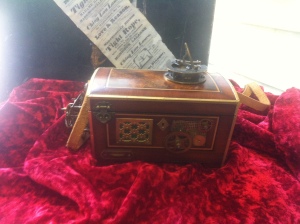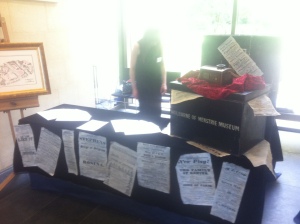The Theatre of Ghosts
I’ve mentioned Ghosts in the Garden before, but the first chance I got to experience it was three weeks ago as part of Museums at Night. Having been piloted last year, the Holburne Museum’s Special Listening Devices were broken out again by Splash and Ripple for an extended season as a paid-for attraction at the museum. For just £5 a family, or any other group or individual, can borrow one of the devices to eavesdrop on late Georgian activities in the pleasure grounds that surround the museum.
The devices are stored in one of the the old metal museum crates in which they were originally discovered. Visitors are asked whether they’d like to hear about the balloon or the fireworks, and once a choice is made, the device is calibrated and then lifted out of the crate and handed to the visitor. At this point the complex clockwork inside the box is ticking loudly, almost as though it’s a bomb about to go off, and one has a sense of apprehension, clutching the surprisingly heavy little box as the safety strap is lifted over one’s head.
Then I’m sent out into the garden to see if I can pick up a signal. As I approach a set of gates, the box vibrates and emits strange noises, and through the aether I can hear a distant voice. The signal gets clear, and M. Merlin, a Francophone inventor and showman, celebrates his success in reaching into his future and our present. He explains that with the box, I’ll be able to wander the gardens and pick up snatches of conversation from the early nineteenth century. He even implies that my presence as an observer might change the course of events, preceding Schrodinger’s theories by more than a century! He suggests some Georgian features of the garden to visit. Sadly most of these structures no-longer exist, but the thoughtful museum staff have provided me with a map, showing where they used to be, so I can find my way around.
Soon I’m embroiled in a story of unrequited love and forced labour. Though I don’t fully understand the Georgian technology at work here, it seems to me that M. Merlin’s invention somehow resonates with moments of high emotion, as I heard nothing of the ordinary humdrum life of the gardeners, or the dowager ladies taking the air in the park. Between the locations where dramatic, emotional scenes took place, all I could pick up were brief snatches of music and one or two words heard almost as if underwater. And yes it seems that just by being there, I’ve altered the course of history, enabling an oppressed young woman to dramatically escape her tormentor.
I rush back to the museum to have my device recalibrated, and then I’m out in the pleasure grounds again, meeting more unsavoury characters and helping them sabotage a fireworks display.
Part of the success of Ghosts in the Garden, I think, has nothing to do with the boxes or the way the stories are scripted. Rather it comes down to good old fashioned theatre. The Museums at Night event marked the moment when responsibility for day-to-day running of Ghosts in Garden passed from Splash and Ripple to museum staff and volunteers. I was privileged to watch, first Splash and Ripple staff hand over the listening devices to visitors, and then Holburne museum volunteers doing the same job. As you might expect, the volunteers, on their first day on the job, were less experienced and less confident in what they had to say. When Splash and Ripple wove the magical story of the discovery of the devices during the museums redevelopment, and the care that must be taken when tuning into the past, children listened with open mouthed belief, and adults played along with good natured engagement. The volunteers hedged their bets as they told the same story, adding the occasional “apparently” and “they say”, and sharing their scepticism with the audience. So they didn’t quite manage to engage the visitors in the way that Splash and Ripple had.
It was their first day. Splash and Ripple were also watching how they handled the theatre, and I’m sure were going to offer some constructive feedback. So by now I’m sure the museum staff and volunteers are all confident old hands, doing their bit to create the magical landscape that the special listening devices reveal. And they are helped in maintaining the illusion by the brilliant way in which the boxes tick as they are calibrated, taken out of the museum crate and handed over to the visitor. This sound effect alone is a brilliant piece of theatre.
And the whole experience, just a day or two after I met with my supervisors, has had me thinking about what it is that makes some interpretation companies technologists and others storytellers. I’m wondering whether all interpretation companies think of themselves as storytellers first and foremost, even though some are obviously better at it than others? I’m also wondering whether cultural institutions reserve the storyteller role for themselves, and consider most of the companies they commission as “mere” technologists, providing the platform upon which the story is told?
It seems obvious to me now, looking back on projects I’ve been involved in my life on both sides of the provider/commissioner fence, that the most successful projects have often been where the commissioner has not tried to retain the storyteller role, and the provider has been given the freedom to become the storyteller. Or maybe in the Pleasure Gardens context, impresario would be a better word?
(Ghosts in the Garden runs at the Holburne Museum, Bath, until 29th June)



